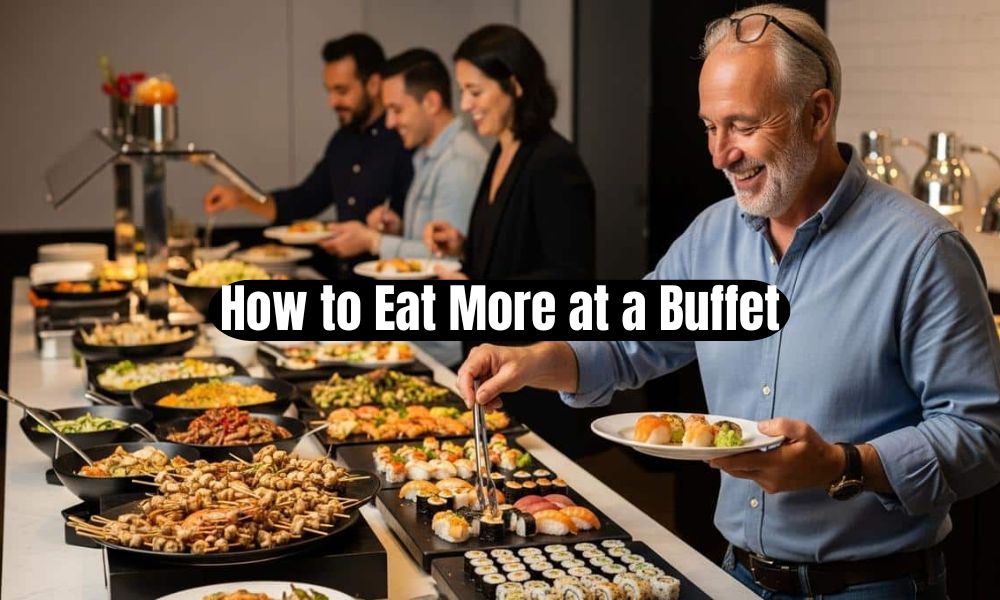Eating at a buffet can be both exciting and challenging, especially if you want to eat more at a buffet and get the most out of your dining experience. Whether it’s a casual lunch or a lavish dinner spread, knowing how to approach a buffet strategically can help you enjoy more of what’s offered without feeling overwhelmed or stuffed. This comprehensive guide is designed to help beginners navigate buffets confidently, maximize their enjoyment, and manage portions effectively. https://creativehguide.com/how-much-to-tip-at-buffet/
Understanding Buffets: What Makes Them Different from Regular Meals

Buffets are unique compared to traditional sit-down meals. Instead of ordering from a fixed menu, you can serve yourself and sample a wide variety of dishes. This freedom allows you to explore multiple flavors, try small portions of different foods, and enjoy a more personalized dining experience. However, buffet service is usually limited to drink refills and plate clearing, so understanding this difference helps set expectations and ensures you approach your meal with the right mindset.
Planning Your Buffet Strategy: Timing, Appetite, and Mindset

Before stepping into a buffet, planning is key. Timing your visit can affect what dishes are available—arriving when the buffet opens usually means fresher options, while peak hours may offer fewer choices. Pay attention to your appetite: being moderately hungry is ideal. Avoid skipping meals beforehand or going in overly full. Most importantly, maintain a positive mindset. Approach the buffet with curiosity and fun rather than focusing solely on eating as much as possible.
Types of Buffets: Casual, Fine Dining, and Specialty
Casual Buffets
Casual buffets, like chain restaurants or local eateries, offer simpler dishes with minimal service. Portions are smaller, and self-service is the norm. Pacing yourself is crucial to enjoy a variety of options without getting full too quickly.
Fine Dining Buffets
Fine dining buffets feature higher-quality ingredients and more curated selections. Servers may assist with drink refills or plating special items. Take smaller portions of premium dishes to savor every bite while leaving room for other offerings.
Specialty Buffets
Specialty buffets, such as seafood nights or dessert-focused spreads, require targeted strategies. Identify must-try dishes in advance and avoid filling up on less important items to maximize your experience.
Arriving Hungry but Smart: How to Prepare Before You Go
Preparation enhances your buffet experience. Light exercise, a small protein-rich snack, or staying hydrated can optimize your appetite. Avoid high-calorie drinks or snacks just before the meal, as they may fill you up and limit your ability to enjoy the full buffet.
Surveying the Spread: Assessing Your Options Before Digging In
Before filling your plate, take a slow walk around the buffet. Observe all the options and identify unique, seasonal, or favorite dishes. This strategy prevents overloading your plate with items you may not enjoy and helps plan a path for multiple rounds efficiently.
Portion Control and Plate Planning: How to Eat More Without Wasting

Controlling portions is key to sampling a wide variety of dishes. Start with small servings of each item to avoid filling up too quickly. Using a smaller plate tricks your brain into feeling satisfied faster while reducing food waste. Remember, multiple trips to the buffet are better than overloading your plate in one go. Strategic plate planning ensures you can taste everything you want without regret.
Pacing Yourself: Step-by-Step Guide to Maximize Your Meal
Eating more at a buffet isn’t about rushing; it’s about pacing yourself thoughtfully.
First Round: Sampling
Begin with small portions of several dishes to discover what you enjoy most. Focus on trying new items instead of filling up on familiar favorites immediately.
Second Round: Favorites
Return for a second round focused on your preferred dishes. Slightly larger portions here allow you to indulge mindfully while still saving room for other courses.
Dessert Round: Sweet Strategy
Finish with desserts strategically. Select one or two sweet items and savor them slowly to enjoy the flavor without overwhelming your stomach.
Choosing the Right Foods: Protein, Carbs, and Vegetables
Balancing your plate with proteins, carbs, and vegetables can help you eat more efficiently. Proteins like chicken, fish, or beans keep you full and satisfied. Moderate carb intake provides energy, and vegetables are low-calorie, nutrient-rich fillers that leave room for other foods. Combining these wisely ensures a full, enjoyable meal without overindulgence.
Strategic Seating and Timing: How Location Can Help You Eat More
Your seating and timing can subtly improve your buffet experience. Sitting near the buffet allows multiple quick trips, while a comfortable, well-lit table encourages slower, more enjoyable eating. Visiting during less crowded times ensures fresh food availability and a more relaxed pace.
Hydration Tips: Drinks That Help, Not Hurt, Your Appetite
Beverages can affect your appetite. Avoid sugary drinks or heavy beverages before your meal. Instead, sip water throughout to stay hydrated without taking up valuable stomach space. Light drinks like sparkling water or unsweetened iced tea can cleanse your palate and enhance your tasting experience.
Dealing with Buffets During Holidays or Peak Times
Buffets can be challenging during holidays or busy hours due to crowds and limited dish availability. Arrive early or during off-peak hours. Stay patient and flexible, adjusting your plate strategy as food is replenished. Remaining calm ensures you enjoy variety without stress.
Mindful Eating Tricks: Eating More While Enjoying Every Bite
Mindful eating helps you savor flavors and textures, allowing your stomach to signal fullness appropriately. Slow eating prevents discomfort, leaves room for multiple rounds, and encourages you to try new dishes thoughtfully.
Using Mental and Physical Tricks: Stretching, Walking, and Appetite Boosters
Small tricks can boost your buffet performance. Light stretching or walking beforehand stimulates appetite. Pausing briefly between rounds and visualizing which dishes to try first helps you pace yourself strategically, making the buffet more enjoyable.
Avoiding Common Buffet Mistakes: Overfilling, Rushing, or Skipping Essentials
Common mistakes include overfilling your plate, rushing through dishes, or skipping essential items like proteins and vegetables. Focus on balance, pacing, and portion control to maximize your meal without discomfort.
Post-Buffet Recovery: How to Feel Good After Eating More
After your meal, take care of your body. Light walking or stretching aids digestion, hydration supports recovery, and avoiding overeating afterward allows your body to process the meal comfortably. Post-buffet care ensures a positive dining experience.
Bonus Tips and Hacks: Insider Secrets to Eating More at a Buffet
Start with lighter items to save room for richer dishes later. Observe when the buffet is replenished to time your rounds for freshness. Ask staff about off-menu items or specialty dishes to discover hidden gems. These hacks help you eat strategically while keeping your experience enjoyable and stress-free.
Final Thoughts
Eating more at a buffet is about planning, strategy, and mindful enjoyment. By understanding buffet types, pacing yourself, controlling portions, and choosing the right foods, you can enjoy a wide variety without discomfort. Combine these tips with hydration, mental and physical tricks, and insider hacks to make the most of every buffet visit. The key is to enjoy every bite, try new dishes, and leave feeling satisfied and happy.
